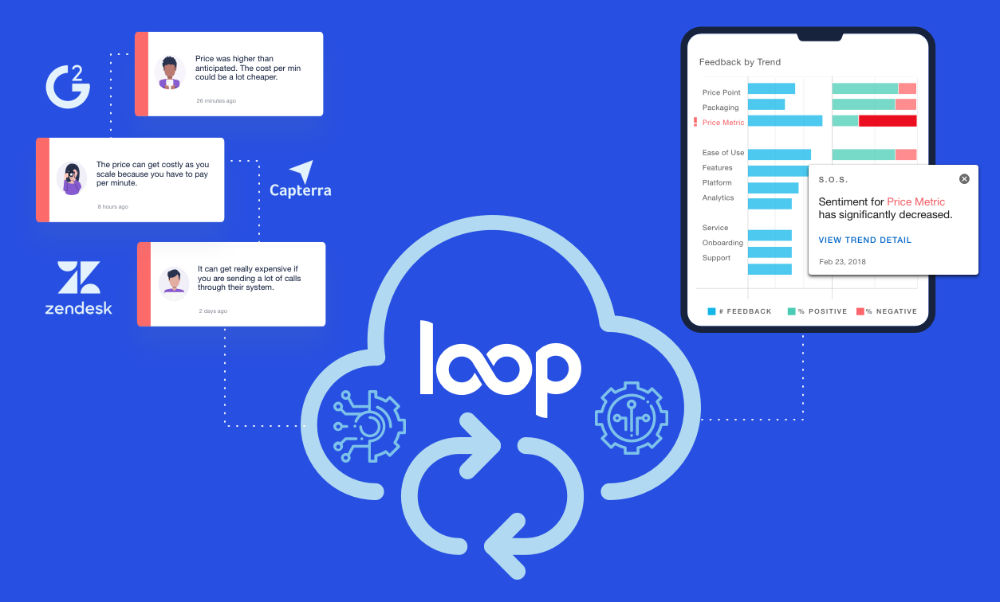Home » How To Build A Voice of the Customer Program At Your SaaS Company
How To Build A Voice of the Customer Program At Your SaaS Company
Madeline Turner

Over the past decade, there’s been a hyper-focus on creating business strategies centered on customer loyalty, needs, and success. From inbound marketing to customer advocate programs, organizations have strived to meet customers where they are and create products and services that turn buyers into passionate fans of our businesses. To achieve this, organizations have prioritized building relationships with customers—marketing and post-sales strategies are no longer created in a vacuum. Instead, we’re asking for feedback, conducting win/loss calls, featuring customers in our content, and creating teams focused solely on promoting customer success. And as we continue to get smarter about how we engage our customers, we learn more about the opportunities (beyond net promoter scores) that are still untapped.
More recently, the SaaS industry has started discussing the importance of Voice of the Customer (VoC) Programs as part of the larger effort to become more customer-centric. While Customer Success serves to drive customer usage and success in your products and Customer Support focuses on solving product issues, Voice of the Customer programs exist to centralize customer feedback so that businesses can better understand customer needs and challenges related to their experience with your brand and your products. It sounds obvious—creating programs that give visibility to customer and prospect feedback across the organization so that every team can make informed decisions—but organizations are still working to create the framework and identify the technology that makes these programs possible.
Leah Guest, Voice of Customer Platform Coordinator at Zendesk, describes the importance of this role in growing SaaS companies. “There is a huge gap in how product teams prioritize feedback related to strategic product initiatives like features, pricing, and support,” Leah says. “The goal of a voice of the customer program should be to collect feedback at every touchpoint, from face-to-face interactions like conferences and marketing events to everyday transactions via phone calls and emails.”
The biggest hurdle that we see facing SaaS businesses is that all of this feedback is being collected and shared across disparate platforms. From online review sites to customer notes in Zendesk and Salesforce, at every touchpoint customers are sharing business-critical information with and about your company. Our opportunity is to collect, analyze, and act on this feedback to understand major customer trends, and then respond based on the greatest risks and opportunities for the business.
The collection and analysis of this customer feedback is key to answering questions such as:
- Is our pricing model impacting sales?
- Are there critical features missing from our product roadmap strategy?
- Is our latest marketing campaign resonating with customers?
- Do our customers need more training or self-help resources?
- Are we spending our limited resources on the right initiatives that will drive impact?
We devise “war rooms” and go-to-market strategies to help answer and address some of these questions. But maybe too much time is being spent making decisions on behalf of our customers rather than inviting customers to have a seat at the table. This is the value of a Voice of the Customer program: being smarter about using the data already at our disposal so that we can make more informed decisions.
Here are the 5 steps to build your Voice of the Customer program:
1. Get Cross-Functional Buy-in
The truth is that a successful Voice of the Customer program cannot happen without buy-in across your organization. You may be able to collect and analyze customer feedback, but what is the point if you’re unable to act on this data?
Start by identifying Voice of the Customer champions within the following organizations:
- Customer Support
- Customer Success Team
- Sales
- Demand Generation
- Product Management & Product Marketing
There should be alignment on both the vision and the practice of a Voice of the Customer program—what will you achieve by working together and how will we put learnings to practice. The easiest way to get buy-in quickly is to help each organization see the immediate value to their organization.
- Customer Support: An understanding of gaps in the support process in addition to a better view of the channels where customers are expressing their issues. Are support teams adequately trained? Have hold times met customer expectations? Is technical documentation enabling customers to self-serve?
- Customer Success: A more comprehensive view of customer pain points so that customer success managers can create onboarding and engagement programs that more directly address barriers to success. Customer feedback can expose major blindspots across the customer lifecycle, ultimately improving customer satisfaction if the right steps are taken after.
- Sales: Critical information to inform prospecting of new customers, cross-sell and upsell strategies for existing customers, so that frontline sales teams can proactively play offense and defense. Is pricing causing prospective customers to walk away? Are there critical features missing from the roadmap that would help close more deals?
- Demand Generation: Proactive go-to-market campaigns and messaging—what is it that customers really want and need to hear? Are there certain features or value propositions that are most impactful for story-telling?
- Product Management and Marketing: Comprehensive input from users (and non-users) about the features, capabilities, and pricing models that are missing or are impacting product experience. Has platform stability impacted customer retention? Do users expect a simpler user experience at a cheaper price? How have customer needs changed and how does product strategy need to shift to align with those changes?
2. Identify Customer Feedback Channels
Once you’ve received buy-in from key stakeholders, the next step is to identify all of the places customer feedback is being shared:
Public Channels:
- Online Review Sites
- Social Media Posts and Groups
- Customer Communities and Online Forums
- Email listservs
Internal Channels:
- Customer Support Tickets
- CRM Notes from Sales and Success calls
- Phone calls
- Collaboration & chat tools
- NPS, CSAT, and Win/Loss surveys
The next step is to determine how (and how often) feedback from these channels is to be aggregated and assessed. If you do not have a tool that will aggregate this feedback for you automatically, you’ll need to assign channel responsibilities and define a weekly cadence for data to be pulled.
3. Analyze Common Issues
Once you’ve started collecting feedback you can start to identify common issues and correlate those issues with performance metrics (sales, retention, etc.). It will be important to determine the key categories of issues so that you’re able to tie feedback to specific initiatives, such as pricing, product, and customer experience. This will help your team align on ownership as well as the actions that need to be taken.
4. Use Feedback Analysis to Prioritize Strategic Actions
The most important part of a voice of the customer program is closing the loop — using the feedback you have collected and analyzed to prioritize strategic actions and initiatives across the business. Based on the analysis of feedback, you may decide to prioritize pricing changes, changes to the support model, and/ or product roadmap features. And while the goal of a voice of the customer program is to empower your users to drive these initiatives, company politics are hard to avoid completely. The easiest way to ensure alignment on initiatives across internal stakeholders is to have weekly task force meetings. Use this time together to walk through the major feedback themes, prioritize actions based on common issues, and assign ownership to drive accountability.
Steps for developing actions:
- Identify the feedback issue to be addressed (ex: long on-boarding process)
- Assign a level of priority based on potential impact (ex: revenue, retention, time-to-live)
- Determine action(s) and changes required to address the issue (ex: increase implementation headcount, improve UX with a new guided tour)
- Identify resources required to make these changes (ex: time, money, staff)
- Assign ownership of the action
- Set timeline and milestones for changes or rollouts
- Define KPIs and process for measuring the impact
These regular meetings will also ensure that real-time customer feedback is being shared and that visibility and accountability for the action plans are put in place.
5. Monitor the Impact
Of course, the key to getting long term support and buy-in depends on your ability to prove results. To do this, you will need a process that maps feedback to changes made and alignment on the KPIs that will be measured.
For instance, if there is a customer feedback trend around pricing, you may develop actions to update your pricing metric or packaging strategies. In this case, you would track feedback received related to pricing after the new pricing is released, as well as the impact on your sales revenue. If feedback related to the trend becomes more positive and sales impact increases, it is likely that you have the right strategies in place. If you do not see the impact improving, you have probably not solved the root cause of the issue, and it is time to try something new. Based on your business, it is important to give actions enough time to be effective, while not waiting too long to shift course.
The important thing to remember is that just as customer feedback cannot (or should not) be collected in a silo, decisions on how to address and measure the changes made to address this feedback cannot be decided alone.
Having the right technology to make all of this scalable could be key to the success of your Voice of the Customer program. With Loop, B2B SaaS companies can get real-time visibility to feedback trends and progress to actions so that all stakeholders have access to information they need to make smarter decisions and reduce churn. You can try Loop for free today.


